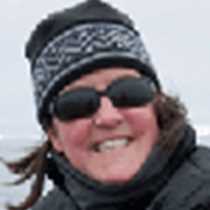Poolepynten & Konowbreen Bay
Our first landing was at Poolepynten, at a beach with a traditional walrus haul-out site. Naturalists led small groups first along the beach and then into the tundra. We slowly made our way across the beach as the Arctic terns aggressively defended their nesting sites. Throughout the walk we discovered a variety of wildflowers including the abundant and colorful purple saxifrage.
The walrus were resting near the end of the beach and we stopped at the area where we counted 40-50 male walruses. They were huddled closely together as they are in the middle of a catastrophic molt; this is when they shed their fur all at once. While they looked just like a large pile of slugs, on the contrary molting is an energy intensive activity. In order to conserve body heat the walruses lay side by side or on top of each other. They may stay on the beach for up to three weeks without returning to the sea to feed before the molt is finished. We saw only male walruses as the females are found further north with their young. It was an incredible opportunity to be so close to such large animals as the largest male may have weighed over 3,000 pounds!
In the afternoon we enjoyed our first outing in the kayaks in Konowbreen Bay. We had the chance to kayak amongst the bergy bits of brash ice and discovered a bearded seal resting on a small iceberg. The glacier face may have been as high as 300 feet and it was a unique perspective to look up at this massive wall of ice from the kayaks.
The non-kayakers had a long leg stretch and went for a hike up a rather steep hill with a fantastic view of the glacier and the surrounding area. All in all it was a wonderful way to start this week's special journey.



